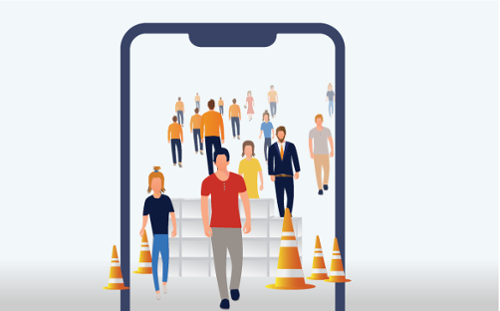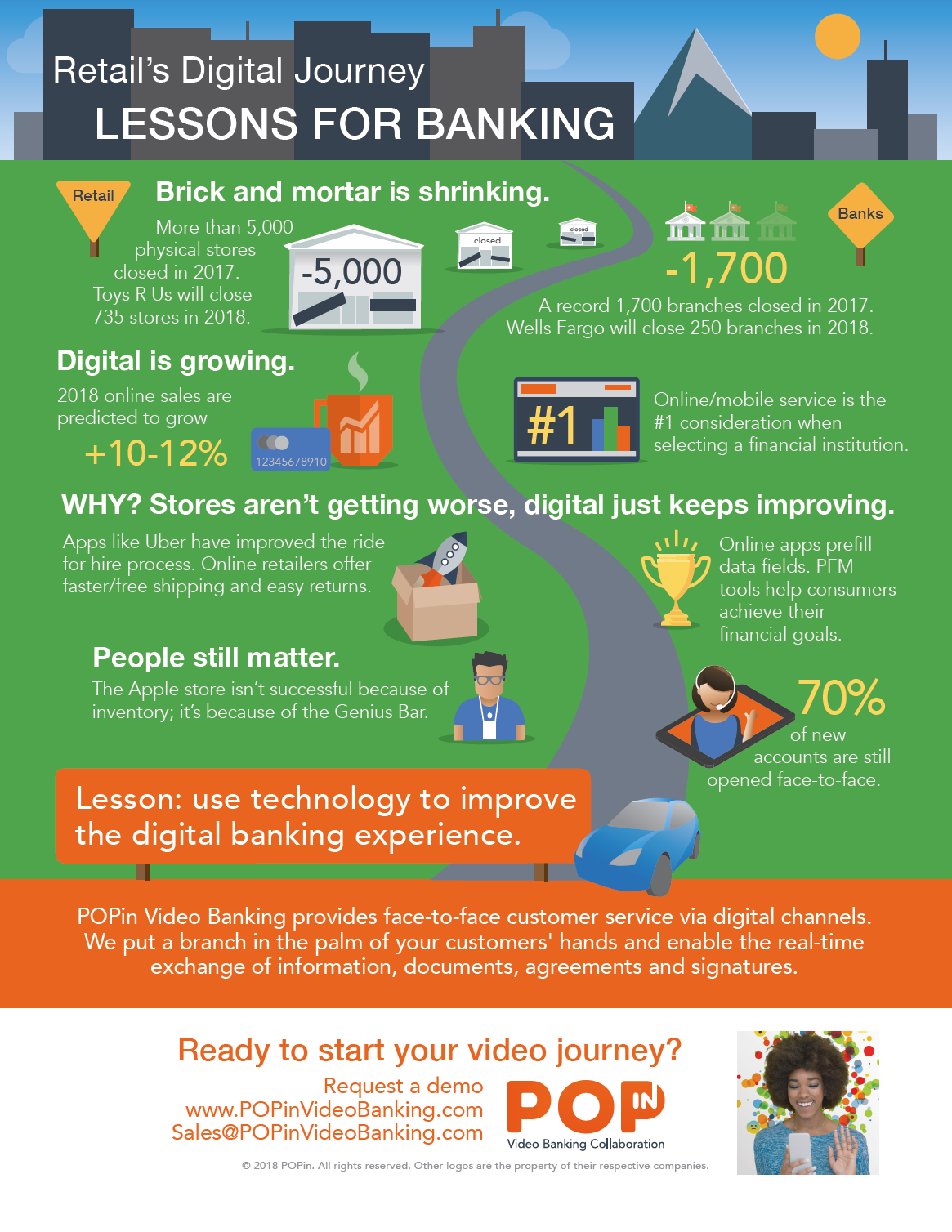Pioneer Federal Credit Union explains how video banking enables members to do nearly anything they need from everywhere.
Pioneer Federal Credit Union discusses how you can serve more through video banking.
Pioneer Federal Credit Union discusses their strategy and why they won’t be forcing members to go into a branch.
Pioneer Federal Credit Union discusses why pricing was not a blip on their radar, and how the ease of implementation made it worth every penny.
South Bay Credit Union discusses why video is different, and the level of engagement they are able to achieve with video banking.
South Bay Credit Union discusses how video banking has enabled them to educate members on the self-service tools readily available to them.
South Bay Credit Union discusses how video banking can help credit unions fight fraud by verifying members face to face before they perform certain transactions.
South Bay Credit Union discusses how POPi/o Video Banking has helped change their delivery strategy.
South Bay Credit Union discusses how their members have reacted to mobile video banking as they have rolled it out to their membership.
Southwest Financial Federal Credit Union discusses how they are able to leverage video banking to serve members everywhere.
Southwest Financial Federal Credit Union discusses how members are accepting this new more personal channel of communication.
Southwest Financial Federal Credit Union discusses how video banking is a comprehensive solution that can be implemented in a number of different ways.
Southwest Financial Federal Credit Union describes how video banking can help you reduce loan loss among new and prospective members.
Texas Tech describes why they chose video banking, and what it means for their strategy moving forward.

Mobile channels are supposed to improve convenience, but most mobile banking apps have fallen flat. According to a recent Magnify Money report published in The Financial Brand, consumers gave mobile banking apps an average rating of 3.7 out of 5, a merely average 74% score.
The culprit is friction – all of that red tape that kills convenience. Eliminating friction is the primary objective of POPi/o Mobile Video Cloud’s video banking solution. We’ve been thrilled to hear how our clients have utilized mobile video to reduce friction and create a better experience that builds sales and brand loyalty.
Here are four common convenience killers and ways mobile video can eliminate them.
#1 Onboarding
We’ve all seen the dismal online and mobile loan application abandonment rates, which can be as high as 98%. When Southwest Financial FCU launched POPi/o in September 2017, its primary goal was to increase loan volume by decreasing friction in the lending process due to the credit union’s largely remote membership. In particular, Southwest Financial was still asking consumers to fax signed loan documents to complete applications. The result was a frustrating 80% loan application abandonment rate. Consumers were put off by the inconvenient process, and employees were wasting time calling to follow up on docs that never arrived. With POPi/o video banking, loan apps are signed, sealed and delivered with just one call.
#2 Authentication
Wire fraud is a big problem for financial institutions, with losses at mid-sized banks and credit unions running as high as tens of thousands of dollars per month. In July, the FBI issued an alert warning against a new scam in which a bad actor accesses a legitimate email account to request unauthorized wire transfers. The FBI reported that there have been more than 41,000 victims in the U.S. alone, accounting for a total of $3 billion in fraudulent wire transfers. Many of our clients use video banking to verify wire transfers. Not only does video banking make verification compliance more convenient for consumers, the institution can also use facial identification to confirm it’s really their consumer requesting the transaction.
Download FREE Benefits of Video Banking Article
#3 Navigation
As consumers, we’ve all experienced poorly designed apps that aren’t intuitively organized and don’t provide the information we need. We may spend a few moments trying to navigate around the app to find what we want, but it doesn’t take long before we abandon the effort. Video banking isn’t an end-all solution for a poorly designed banking app, but it can reduce friction by providing quick and easy access to subject matter experts. South Bay Credit Union uses POPi/o video banking to provide fast, face-to-face access with experts, who may be located centrally or in a branch. No matter where consumers are, they can connect instantly, with no navigational friction involved.
#4 Communication
Taking navigation one step further, if a consumer experiences a technical problem or questions a transaction using a mobile banking app, immediate access to a service representative isn’t always available. POPi/o Video Banking not only provides immediate face-to-face service, representatives can utilize the app’s screenshare feature. This enables your employees to show – not just tell – consumers how to resolve issues. POPi/o Video Banking is also very helpful when assisting consumers who don’t speak English. Pioneer Federal Credit Union uses POPi/o Video Banking to assist Spanish speaking members, who often want branch service but sometimes arrive to find no bilingual employee on duty. Video banking allows the credit union to draw upon its centralized staff to quickly find a bilingual employee, providing clear communication to non-English speakers in any branch, or wherever they may be.
What happens next? You slay even more.
POPi/o Video Banking eliminates nearly all mobile convenience killers. Our bank and credit union clients continue to impress us with the innovative ways they’re using our solution to reduce friction and improve their consumer experience. If your brand loyalty is on the ropes because of a convenience killer, give us a call. We can bring your mobile service experience back to life.

For months, financial services leaders have been wondering if Amazon will enter the mortgage market. Perhaps they’re asking the wrong question.
Whether or not Amazon offers mortgages doesn’t even matter because Quicken Loans’ Rocket Mortgage has already upended the financial services market. Quicken Loans is currently the nation’s top mortgage lender by volume, originating $20.5 billion in the first quarter of 2018. Rocket Mortgage not only streamlined the application process to eight minutes, it has reduced closing time on purchases to just 16 days.
Quicken Loans isn’t the only mortgage lender that has reduced friction for borrowers. In fact, so many lenders provide such an advanced mortgage lending experience, Amazon may take a pass on the mortgage market because they currently don’t see enough opportunity to gain a competitive advantage.
Most agree that credit unions and banks need to upgrade technology to provide a customer experience that competes with these fintechs. However, financial services leaders are wrong when they think better hardware, more digital delivery channels and improved efficiency are the answer.
Fintechs approach technology differently, baking in innovation instead of just bolting it on. They are organized around customer needs; the customer experience drives operational strategy. Traditional financial institutions, in contrast, are still focused on product and functional silos. Instead of supporting innovation by dynamically adjusting operations, most FIs change one process, function or technology at a time.
Digital channels have eliminated the curtain between front and back office operations. Customers expect automated applications that fill personal information fields from their account data and other sources. They expect tracking tools that keep them informed of exactly where their mortgage loan approval stands in real time.
This back office emphasis has produced a dramatic increase in application abandon rates. According to a 2016 SaleCycle blog, consumers abandon a whopping 80 percent of online financial applications.
A common reason cited is the application process takes too long. According to a 2016 study by Signicat, the average online app took nearly 18 and a half minutes to complete.
Consumers also say too much personal information is needed when they apply for accounts or credit, a complaint that will continue to increase as data is more easily shared among connected organizations.
Financial institutions must reduce digital friction to maintain market share. The Financial Brand identified five ways banks and credit unions can improve their application process to reduce friction and improve abandonment rates. They include:
- Use mobile first design. That means minimizing fields, reducing keystrokes and minimizing scrolling because they take effort on mobile devices. Mobile is how your customers are increasingly interacting with your institution.
- Offer save and multichannel functionality. Requiring a restart always leads to high abandon rates.
- Make the experience 100% digital. It’s hard to believe this needs to be said in 2018, but requiring consumers to visit a branch to finalize an application makes abandonment rates skyrocket. All processes should support digital signatures and support electronic document submission.
- Onboard the requested product first. Resist the temptation to cross sell until after the application is complete.
- Recover abandoned applications. Collect the important information first, like name, email and phone number. Then, follow up on abandoned applications as quickly as possible. Not every abandoned app means the consumer changed their mind.
By the way, just because you offer amazing digital service doesn’t mean consumers will be satisfied. According to April 2018 research from J.D Power, digital-only customers are far less satisfied than customers who use both digital and face-to-face service. That’s because communication is where banking relationships typically fall short, the research revealed. The solution is to include highly personalized digital interactions along with transformed branch experiences that serve the needs of both digital-centric and branch-dependent customers. Which is exactly why we invented POPin Video Banking, to bridge that gap, improve communication and reduce friction.
So back to Amazon entering the mortgage market. If the market is already saturated with fintechs that provide frictionless service that rivals Amazon, tomorrow is too late to transform your innovation culture. You must begin today.

Losing the Relevance of Bank Branches
The migration from branches to digital channels continues. According to a Feb. 8 report in The Wall Street Journal, the banking industry closed 1,700 branches in the 12 months ending in June 2017, this was the largest one-year decrease ever.
Not only are branch numbers falling, but the relevance with the consumers is falling too. I’m sure you remember the day when branch location was the primary decision criteria when selecting a new bank or credit union. Now it’s fallen to third place according to Novantas research (2017 Omni Channel Shopper Study). A superior digital banking experience is now number one. In a different study (2017 Account Opening and Onboarding Benchmarketing Study) they found that about one-third of all consumers prefer to open their account digitally.
Looking at all of this research, it would appear that consumers increasingly prefer digital service over face-to-face branch service.
But not so fast.
Digital Channels, still not Engaging
While consumers continue to adopt digital channels, they’re not exactly thrilled about the service they’re receiving. A January poll of more than 1,600 digital banking users revealed that 68% of Americans who have used digital banking in the past year were frustrated by the experience. One-third polled were so frustrated, they told Harris Poll and D3 Banking Technology, they were willing to leave their financial institution in search of a better digital experience.
The report, as well as Novantas research, indicated two digital banking pain points for consumers.
- First, many institutions haven’t evolved digital banking beyond basic transactions, like checking account balances or transferring funds. Consumers want more – at a minimum, mobile deposit, P2P and mobile account opening. Savvy consumers are already asking for artificial intelligence capabilities, biometrics, and voice-driven interfaces.
- Second, most digital banking solutions don’t provide optional human engagement. In the event of a problem, most systems require the user to abandon the digital channel and seek a phone representative or branch employee.
Creating Digital Engagement
What’s the difference between digital transactions and digital engagement? About an hour. On average, Facebook users spend about an hour each day on the social media platform. Compare that to roughly 54 seconds a day that typical customers interact with a leading global retail bank and it’s clear that financial institutions are missing the engagement mark.
The retail engagement has changed drastically over the last 10 years. Rather than talk at customers, educating them about the benefits of products and services, companies now speak with them. The difference is two-way dialogue that listens to customers’ wants and needs … a lack of two-way dialogue defines the digital engagement gap.
Eliminating the digital engagement gap can seem overwhelming to a financial institution struggling to do it all – provide high-touch service to those who need it and high-tech service to those who want it – all the while complying with myriad regulations.
Is there hope to make Digital more Engaging?
Absolutely. Going forward, banking strategy must partner with third-party technology providers to create two-way conversations and transition from a transactional data mindset to an engagement mindset. Without it, banks and credit unions will be left behind, relegated to little more than transaction facilitators while business models that focus on engagement will win more complex and profitable functions, like lending and wealth management.
POPi/o Video Banking is an excellent way to improve digital banking engagement. Providing an on-demand video representative provides consumer with the reassuring touchstone of human problem-solving they crave in a branch … but with the convenience of having that branch like experience in the palm of their hand. POPi/o Video Banking can expand a financial institution’s footprint in a meaningful way beyond branch locations because the platform supports document sharing, signature capture, and workflow management. We even monitor emotional expressions to give video representatives positivity coaching tips that ensure customer satisfaction.
POPi/o Video Banking is a two-way digital engagement solution. Together, we can advance banks and credit unions into the digital age and transform consumer banking.
Visit our homepage to learn more about POPi/o!
Need to get in touch with POPi/o? Click here >
What is video banking? Learn more here >

Consumers want to use digital channels and FI’s need to adapt and move towards a digital first strategy. As the financial industry goes through this transition, we can learn a bit from Retail’s Digital Journey.

Visit our homepage to learn more about POPi/o!
Need to get in touch with POPi/o? Click here >
What is video banking? Learn more here >

Before we even get started, I need to clear the air. I believe it would be dishonest, disingenuous and even misleading for me to express my opinion without you knowing what I am.
I am a millennial.
I am also a fintech executive.
I will never forget attending BAI a number of years ago. I watched a group of suits, at least 60 years old or older, discussing and hypothesizing why millennials were giving them so much trouble.
The dialogue went something like this: Millennials are lazy. Millennials are entitled. Millennials whine. Millennials have no idea what the world is or what is expected, and they avoid hard work.
No solutions. The takeaway was simply: millennials need to change. The End.
Really?
Here’s why that narrative presents a problem and a challenge for the banking industry. According to The Financial Brand, 71% of our diverse and highly educated generation, representing more than 25% of the U.S. population, would rather go to the dentist than listen to what financial institutions are saying.
Millennials also contribute more than $1.3 trillion to the economy in annual spending. By the way, we want to spend money on financial services. A recent Accenture study revealed our top financial goals include building up an emergency fund (64%), saving for retirement (49%), and buying a home (33%). Nearly half of millennials already have $15,000 or more in savings, and 16% have $100,000 or more.
We have more access to information than any prior generation. We have high expectations for digital experiences because technology has been continuously pushed into our hands since we were young. Thank you, by the way. (Sincerely)
We are also a generation looking for a partner who can deliver the help we need in filling our financial education gaps. Two out of every three millennials say they want their financial institution to give them software so they can keep track of transactions, payments and other financial data in real-time, and then use that data to provide better recommendations. When accustomed to living an instant Amazon Prime-level of personalization, speed and service, the lack of evolution in financial services at a bank or credit union can be frustrating.
Admittedly, we are not a patient generation, but we are grateful for the few banking advances that delight.
Remote check deposit. AMAZING.
Pay my friends or businesses without a card. INCREDIBLE.
Give us more to rave about. Here’s what your financial institution can do to meet us halfway.
First, sell me what you have, not what you hope to have. Removing the disparity between those two things will make business with millennials much easier. When you use the words “fully online” or “instant approval,” and then ask me to come into a branch, know that I am walking away. In this day and age, words are more important than ever.
Second, allow more access. Make it easy for me to access the resources I want when it is most convenient for me, without misleading marketing. And give me access to the resource we both love: your employees. Millennials appreciate companies that successfully use technology to conveniently provide face-to-face, personalized service. POPi/o Video Banking is an excellent example of that mix, which is why I sincerely believe in our value proposition.
Third, you know my financial future (just look at Social Security), so help me get to where I need to be. When I am asking questions or evaluating solutions, pay attention and use your product and service knowledge to offer the best match. I take my financial future seriously, and silly upsells that are unrelated to my needs demeans any prior positive experience.
The good news is your employees are the solution. Email. Phone. Video chat. That is how I get access and work actually gets done on my behalf, with the latter providing an in-branch experience at any hour.
Listening, really listening to your millennial market, is the first step to building a better relationship.
Visit our homepage to learn more about POPi/o!
Need to get in touch with POPi/o? Click here >
What is video banking? Learn more here >

Millennials, millennials, millennials.
All financial institutions work hard to attract these young adults born between 1982 and 2000. According to the U.S. Census Bureau, they number more than 83 million and are beginning to represent a significant portion of the economy.
If you want to attract millennials, you must offer top notch digital service – there’s no doubt about that. But what about the rest of your customer base, which prefers face-to-face branch service?
Or do they?
Many POPi/o Video Banking clients have been surprised to discover the digital channel has appealed to far more customers than just millennials. Some of these markets have been downright shocking. Here are five unexpected video banking customers you could potentially serve better with video banking.
- Spanish speakers. A sizable segment of the U.S. population – 21%, or roughly 61 million people – speak a language other than English with Spanish topping that list at about 38 million. And those Spanish speakers aren’t only located near the southern border. Pioneer Credit Union, an Idaho institution that has $430 million in assets, refers its Spanish-speaking members to the video call center for immediate assistance when no multilingual branch representative is on duty. This is a huge advantage for staffing and scheduling Pioneer’s 14 branches. And, Spanish speaking members are more confident their questions can be answered anytime during the credit union’s service hours.
- Fraud victims. Customers who suspect fraudulent activity involving their account usually don’t have time to drive to a branch to resolve the issue. They need immediate assistance, and mobile video banking is just a click away. Video calls also add an additional element of security, because employees can verify that they are speaking to the account holder through visual identification.
- The elderly. Baby boomers and the Silent Generation aren’t often considered when financial institutions estimate ROI for digital technology, but Pioneer Credit Union video call reps have reported that elderly members with limited mobility often prefer to conduct their banking over a video connection from home. Why? Because they feel as though they are burdening their families by requesting rides to a branch to conduct their banking. For some members, video banking has meant the difference between maintaining financial independence and surrendering control to family members. Video banking can also prevent elder financial abuse, which often occurs when seniors trust care workers or people who befriend them with the intention of committing financial fraud. Best of all, POPin Video Banking is as easy to use as FaceTime or Skype, which many retirees already use to communicate with children and grandchildren.
- Wire transfer customers. One of the first CFPB regulations required far more work on the part of financial institutions to facilitate wire transfers. One particularly onerous regulation requires verification of the wire transfer from the customer before it can be sent. South Bay Credit Union President/CEO Jennifer Oliver said her employees use video banking to verify wire transfers rather than making the customer visit the branch or returning a phone call.
- Loan co-borrowers. Obtaining multiple signatures from parties when a loan has more than one borrower can slow the approval and funding process. Mobile video banking app can obtain signatures from multiple individuals during a live video chat by connecting another call into the conversation, or offline at a time that is more convenient for the second individual. POPin Video Banking’s ability to collect signatures and complete documents within the app can be used in myriad other ways to improve lending convenience and the percentage of loan and new account applications that are successfully completed.
Many other unexpected markets love video banking, and there are probably plenty more of which we aren’t even yet aware. You can hear more about how POPi/o Video Banking is the new face of service by watching our new POPi/o TV channel, in which we interview executives at financial institutions so they can tell their stories. Click here to view them.
Visit our homepage to learn more about POPi/o!
Need to get in touch with POPi/o? Click here >
What is video banking? Learn more here >




